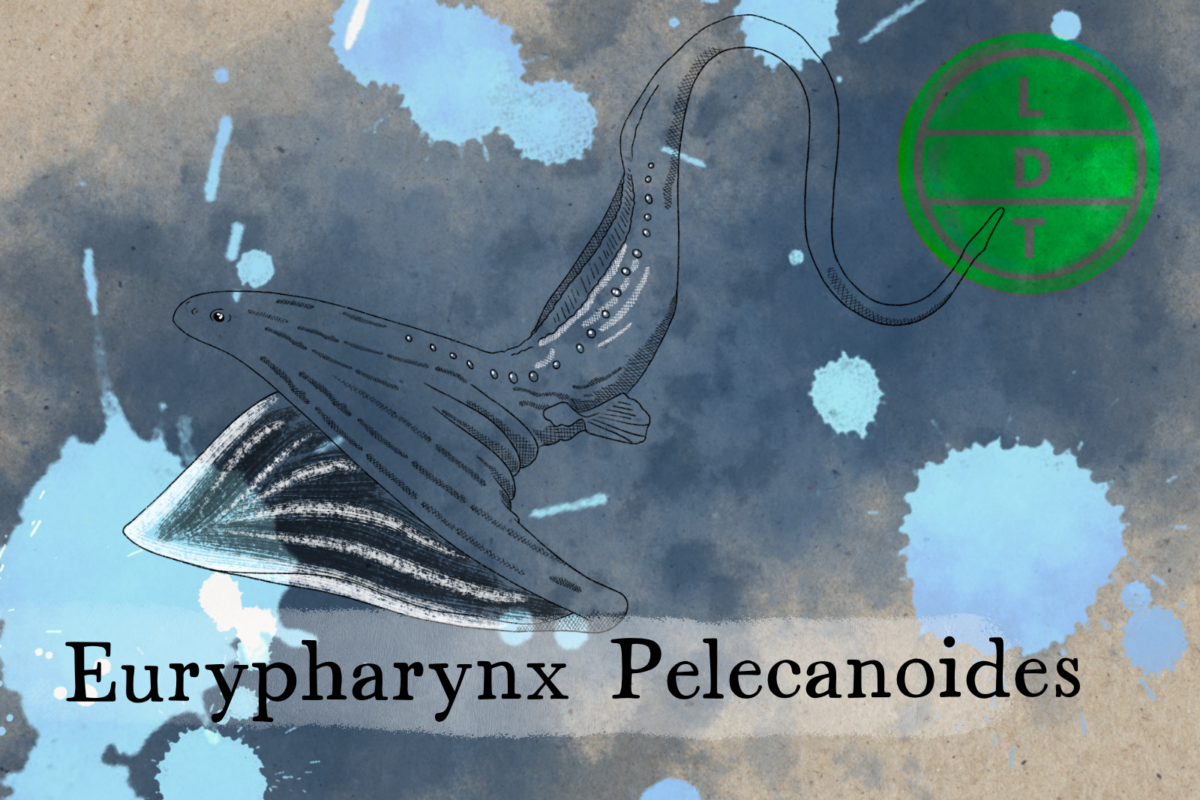“…and today we’re talking about a big-mouthed, deep-living, inflatable tube man. But more on that later.”
Americans have just enjoyed a holiday of abundance. Many of us have funneled turkey into our gobblers with mirth and glee. But what if you lived in a place where food was less abundant. That’s where the spirit of thankfulness comes in. At the bottom of the sea, the pelican eel really does become a funnel to make the most of the marine snow that trickles down from above. But this year, we can all be thankful that we don’t live in the deep ocean for our entire Life, Death, and Taxonomy.
Description
- The epitome of a deep-sea monster, just not gigantic
- You look at these fish and they look horrifying so you assume that they’re huge but they’re really regular fish sized
- This would have been a perfect addition to the “there’s always a bigger fish” scene in Star Wars Episode I
- It’s tail is long, thin, and snake-like. Like most eels, its serpentine tail is like a flat ribbon on its edge.
- The tail is lined with little tentacles that look like hairs and has a little bioluminescent section at the end that gives off red flashes of light for communication and potentially to lure prey.
- Its body is reminiscent of the black anglerfish – basically just one large head but with an even bigger evil smile.
- It has two teeny tiny eyes, which is unusual for something that lives in such low light areas.
- It also has two ridiculous-looking pectoral fins for steering.
- Part of my thalassaphobia is the idea that a mile-long version of this is just lurking at the bottom of the ocean looking up at me deciding whether or not I’m a morsel worth swallowing.
Measure Up
Welcome to the beloved Measure Up segment. The official listener’s favorite part of the show! The part of the show when we present the animal’s size and dimension in relatable terms through a quiz that’s fun for the whole family. It’s also the part of the show that’s introduced by you when you send in audio of yourself saying, singing, or chittering the words Measure Up into ldtaxonomy at Gmail dot com. We don’t have a new Measure Up intro!
Length
- 0.75 m (2.5 ft)
- How many Pelican eels go into the distance Louie Mattar drove in 1952 without stopping?
- Hint: Louie Mattar modified his 1947 Cadillac for five years before he and two other men drove the car across the country and back without stopping.
- 13,347,840 eels. Without stopping, they drove from San Diego to New York and back for a total of 6,320 miles.
Depth
- 1,136–1,154 m (3,727–3,786 ft)
- How many Pelican eel living depths go into the living depth of deepest living multicellular organism?
- Hint: Halicephalobus mephisto, or the devil worm, is the deepest living multicellular animal. Unlike the Pelican eel that can be found thousands of feet beneath the waves, the devil worm lives thousands of feet beneath the surface of the earth. It was found in ore deposits, and discovered by geologists in 2011.
- 3 living depths. The devil worm lives 2.2 miles (3.5 kilometers) beneath the surface of the earth.
Fast Facts about the Pelican Eel
- Range: Lives near the equator across the world’s oceans at depths of up to 9,800 ft. One was found near Greenland and they’ve also been caught near Portugal.
- Diet:
- These guys are difficult to observe thanks to living at the bottom of the ocean and usually not surviving the depressurization of being dragged to the surface.
- Dissecting their guts show that they mostly eat deep-sea crustaceans and cephalopods.
- At first, people thought that they just sat suspended in the water with their bioluminescent tails and waited for food to wander into their mouths. However, recent studies show that they might lunge at their prey or even hunt.
- Behavior:
- They actually have a pretty good sense of smell thanks to some well-developed olfactory organs.
- As juveniles, they are transparent and have no red blood cells. They actually lose their teeth and are replaced with tiny teeth as adults.
Major Fact: Sea Shovel
Pelican eels have a weird body capability that helps it to survive in an environment where there is not a lot of food to eat. They have a massive jaw compared to their body. Their lower mandibles and jaw are much larger than their body length. They are mostly mouth. Even with their tail, their jaw makes up a quarter of their total body length.
Their jaw hinge hangs with no body around it. They open their mouths wide enough to swallow things much larger than they are. The flesh around their mouth is stretchy, like a pelican–allowing them to gulp water and inflate like a balloon.
Likewise, they have stretchy stomachs that can expand to fit the size of very large meals, but they mostly eat small things like crustaceans.
Since food is scarce down in the deep, their large, stretchy mouth allows them to eat a wide variety of food sources. Plus, when they open wide, they can use their mouth like a net to swallow up large groups of shrimp, crabs, and other fun stuff.
They can also gulp small invertebrates by gulping in large amounts of water that is eliminated through their gills. When they are young they feed on marine snow, which is tiny bits of feces and dead cells that descend from the ocean life closer to the surface.
They seem to also use their mouths like a puffer fish, taking in water to expand their body size to intimidate aggressors.
Ending: So shine your light, stay in your depth, and open your abyssal maw to rend the cosmically unknowable fabric of Lovecraftian nightmares like the Pelican Eel here in LDT.

